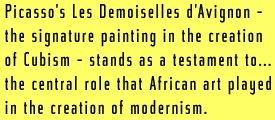"In the paintings of Chicago artist Archibald J.Motley Jr, signs of modernity fused with compositional fracturing and chromatic freedom, resulting in works that, while ever conscious of the figurative tradition, forged ahead with a pictorial dynamism and thematic complexity that complemented works by many European and white American modernists....The artist's recurring fascination with Chicago's 'Bronzeville' community invoked comparison with Stanley Spencer's provincial community and Phillip Evergood's 'taxi dancing' Manhattanites."
"A system of white vetting of black intellectuals and artists ensured
that when the writers or actors veered too far outside of the parameters
of white modernist enthusiasm, the black recipients of white patronage
themselves abandoned. That experience spawned what I would call the 'double
consciousness' of Harlem Renaissance modernism, that is the experience
of feeling oneself at one moment an artist, qua artist, à la modernism,
with considerable inflated social status, and then a Negro, to paraphrase
Du Bois. The lived experience of modernism for many African American intellectuals
and artists in the 1920s included the sense that if one violated the prescriptions
of modernist discourse, if one dared to foreground the historical and contemporary
oppression of peoples of color on one's notion of culture, then one fell
out of the loop. Paul Robeson's struggle to create a career reveals much
about the problem of modernism facing a black artist and about why, in
the 1930's, he broke with the modernist notion of culture to begin an analysis
of the global reach of racism and imperialism."

"Modern aesthetics repeatedly produced and sanctioned the spurious truths of an unjust racial order. Blacks 'negroes' appeared regularly in writing about the nature and essence of western art. Racial difference was repeatedly cited where critics pondered the inability of non-Europeans to produce legitimate and therefore authentic art. These distinctions were often, though by no means always, expressed in the opposition between primitive and civilised. They became central to modern specifications of exactly what art should comprise."
"This New Negro movement, which took at least three forms before Alain Locke enshrined it in the Harlem Renaissance in 1925, took its inspiration from citizens across the Atlantic in Europe. First, in the early 1890s, Dovorák declared the spirituals to be America's first authentic contribution to world culture and urged classical composers to draw upon them to create sui generis symphonies. A decade later Pablo Picasso stumbled onto 'dusky Manikins' at an ethnographic museum and forever transformed European art , as well as Europe's official appreciation of the art form the African continent. Picasso's Les Demoiselles d'Avignon - the signature painting in the creation of Cubism - stands as a testament to the shaping influence of African sculpture and to the central role that African art played in the creation of modernism. The Cubist mask of modernism covers a black Bantu face. African art - ugly, primitive, debased in 1900; sublime, complex, valorized by 1910 - was transformed so dramatically in the cultural imagination of the West, in such an astonishingly short time, that potential for the political use of black art and literature in America could not escape the notice of African intellectuals, especially Do Bois, himself educated in Europe and cosmopolitan to the core, and Alain Locke, Harvard trained, a Rhodes scholar at Oxford in 1906 and thereafter a student of aesthetics in Germany in the heady years of the modernist explosion. If European modernism was truly a mulatto, the argument went, then Africans would save themselves politically through the creation of the arts. The Harlem Renaissance, in so many ways, owes its birth to Euro-African modernism in the visual arts. This Renaissance, the second in the black history, would fully liberated the Negro - at least its advance guard."
Extracts from 'Re/Birth of a Nation' by Richard J. Powell,
'Harlem on Our Minds' by Henry Louis Gates Jr and
'Paul Robeson and the Problems of Modernism' by Jeffrey
C. Stewart
Rhapsodies in Black: Art of the Harlem Renaissance
(London/California: Hayward Gallery, Institute of International Visual
Arts and University of California Press, 1997)
Background image of 'Into Bondage' by Aaron Douglas 1936
[Themes] - [Bibliography] - [Home] - [Credits]